|
|
|||
|
(Back to Preceding Week; on to Next Week) |
|
|
|
Hatch-year male Northern Parula (above) All text & photos © Hilton Pond Center NOT-SO-CONFUSING
The late Roger Tory Peterson (1908-1996) was among the greatest of bird artists to take a brush to canvas. His paintings are both realistic and beautiful but his greatest contribution to natural history was simplified field guides that made identifying all sorts of flora and fauna an easier task for amateur naturalists. Some of his finest images are of various warblers, members of the Parulidae (North American Wood Warblers). Alas, one thing Peterson did has enhanced paranoia among many beginning birders and caused them to throw up their binoculars in frustration. We speak here of calling autumn migrant parulids "confusing fall warblers," giving some folks an excuse for NOT identifying similar but nonetheless unique warbler species.
Indeed, Peterson's A Field Guide to the Birds East of the Rockies devotes two full-color plates to fall warblers in immature or non-breeding plumage (above), which sometimes leads the novice to believe such species can't be identified easily. To his credit, however, Peterson then employs his innovative technique of pointing out precise field marks that DO differentiate various autumn warblers--meaning with a little work they aren't that confusing after all. We've run our mist nets most days in September at Hilton Pond Center and caught numerous species of these not-so-confusing fall warblers. We share their mug shots and profile pictures below as a way of "diffusing the confusing."
All text & photos © Hilton Pond Center Some of the "confusing fall warblers" are anything but . . . such as the immature male Common Yellowthroat (above and below). A yellow throat and black mask--salt and pepper in winter--allows confusion only with the Yellow-breasted Chat, which is twice its size.
All text & photos © Hilton Pond Center Common Yellowthroats are smallish, about 4.25" long. (North America's Wood Warblers vary from a tiny 3.75" to a whopping 6.25" in length.) Female (below) and fledgling male Common Yellowthroats may be a little harder to identify than a male in "adult" plumage. Look for a yellow throat, lack of wing bars and tail spots, and broken white eye ring. (We've captured 353 Common Yellowthroats since 1982 at Hilton Pond Center, making it our fourth most commonly banded Wood Warbler.)
All text & photos © Hilton Pond Center
All text & photos © Hilton Pond Center There are several brown, ground-dwelling parulids that at first glance look less like typical treetop warblers and more like thrushes or sparrows. The Worm-eating Warbler (above and below) may be the easiest of these brown parulids to identify, based on its prominent eye line, alternating tan and black head stripes, and long, heavy bill. The ground-nesting Worm-eating Warbler probably doesn't consume very many "worms," dining instead on caterpillars it finds in clusters of dead leaves. (We've banded 49 Worm-eating Warblers at Hilton Pond Center since 1982.)
All text & photos © Hilton Pond Center
All text & photos © Hilton Pond Center Superficially similar to the Worm-eating Warbler is the Ovenbird (above and below)--at least until one sees the frontal streaking reminiscent of a spot-breasted thrush. In addition, the Ovenbird's head-striping does not include an eye-line, and the crown is usually marked with a rusty streak. The white eye ring is noticeable. (Incidentally, the Ovenbird in the photo above had mandibles that were slightly crossed at the tip.) The Ovenbird takes its name from its habit of building a canopy over its nest, reminiscent of an old-style outdoor oven. (We've banded 213 Ovenbirds at Hilton Pond Center since 1982.)
All text & photos © Hilton Pond Center
All text & photos © Hilton Pond Center Our third brown, ground-dwelling warbler this month was the Northern Waterthrush (above and below), which despite its breast streaking doesn't look at all like an Ovenbird. The Northern Waterthrush ought only be confused with the Louisiana Waterthrush (not pictured); however, the line above the eye is buffy in the Northern and white in the Louisiana. Furthermore, the Northern Waterthrush has speckling on its throat; this area is white and unmarked in Louisiana Waterthrushes. Both species bob their tails when foraging on the ground. (We've captured 316 Northern Waterthrushes at Hilton Pond Center since 1982, our fifth most commonly banded parulid. Louisiana Waterthrushes are more scarce with just 42, but some we've netted have been recent fledglings and females with active incubation patches--a good sign they're nesting locally. Northern Waterthrushes breed much further north, in New England and across most of Canada.)
All text & photos © Hilton Pond Center
All text & photos © Hilton Pond Center To our eyes, the dorsal feathers of the Chestnut-sided Warbler (above and below) come in one of the most unusual shades of green found on any bird. The individual in the first two photos is an immature female, with gray face, white eye ring, and yellow-white wing bars. She'll look different when she returns next spring from the Neotropics, where she will acquire a black mask, streaked back, pure white wing bars, and some degree of chestnut on her flanks.
All text & photos © Hilton Pond Center Young male Chestnut-sided Warblers (below) look pretty much like immature females, except that most have more of the chestnut markings that give the species its name. (Since 1982, we've banded 76 Chestnut-sided Warblers at Hilton Pond Center.)
All text & photos © Hilton Pond Center
All text & photos © Hilton Pond Center If it's a warbler and it's white and black, you can't go wrong in calling a bird a Black-and-white Warbler (above and below)--although if you're out west the Black-throated Gray Warbler also has those color attributes.
All text & photos © Hilton Pond Center
All text & photos © Hilton Pond Center Our "bird of the year" for 2009 very well may end up being the Golden-winged Warbler we netted on 4 September. We've banded just four at Hilton Pond Center since 1982, making it one of our least common Wood Warblers. The species is distinctive, with bright yellow wingbars that give the bird its common name. Immatures lack the dark mask and bib of the adult, but the bird in the photo has enough of the former to make us think it's a young male. Golden-winged Warblers are a species of concern due to habitat loss and because more common Blue-winged Warblers are hybridizing extensively with them. (In addition to the four Golden-winged Warblers, single-digit "rare parulids" banded at the Center include eight Yellow-throated, seven Nashville, four Wilson's, four Orange-crowned, three Connecticut, two Swainson's, and two Blackburnian Warblers.)
All text & photos © Hilton Pond Center
All text & photos © Hilton Pond Center Many of the parulids are sexually dimorphic, with males looking very unlike females of their same species. Such is the case with the Black-throated Blue Warbler, in which the female (above) is so different from the male even John James Audubon initially thought they were different species.
All text & photos © Hilton Pond Center Female Black-throated Blue Warblers are fairly nondescript, but the white wing spot--actually the unpigmented bases of the primary feathers--is diagnostic when present. (Some females have a very faint spot that is quite difficult to see.) Look also for the long white superciliary line and the partial ring beneath the eye. There are no tail spots. There's nothing confusing about the male Black-throated Blue Warbler (spring bird below), nor is there any question about how he got his name. The solid blue crown, back, and tail and the black face and throat are unmistakable. (We have banded 161 Black-throated Blue Warblers at Hilton Pond Center since 1982.)
All text & photos © Hilton Pond Center
All text & photos © Hilton Pond Center The diminutive Northern Parula (formerly Parula Warbler) is the smallest of our Wood Warblers at Hilton Pond Center. These little birds are scarcely 3.75" long--smaller than a Carolina Chickadee and barely bigger than a Golden-crowned Kinglet. Their plumage is a kaleidoscopic mix of blue, gray, yellow, green, and white--the latter color restricted to wing bars, broken eye ring, belly, and undertail coverts. Illustrated here (above and below) is an immature female; the picture at the very top of the page is of a young male with considerably brighter rust-colored necklace that, come spring, will be joined by a second strand of blue-black. (We've banded 57 Northern Parulas at Hilton Pond Center since 1982, including females with active incubation patches that imply local breeding.)
All text & photos © Hilton Pond Center
All text & photos © Hilton Pond Center Certainly one of the LEAST confusing fall warblers is the male Hooded Warbler in adult plumage (above); it would be hard to mistake the sharply contrasting black and yellow markings of this brightly colored creature with any other species.
All text & photos © Hilton Pond Center Females (below) are a different matter, so look for prominent white tail spots and a yellow line above the eye. It's worth noting occasional females have hoods almost as dark as those on males. (We've banded 50 Hooded Warblers at Hilton Pond Center since 1982. Again, recent fledglings and females with incubation patches indicate the species is breeding on-site or very close by.)
All text & photos © Hilton Pond Center
All text & photos © Hilton Pond Center Another parulid in which the two sexes look very different is the American Redstart. Females (above and just below) and young males are gray-green with conspicuous yellow at the bend of the wing and base of most tail feathers. In many young males the yellow tends to be more salmon-colored. Note also the broken white eye ring and the pale line between the base of the upper bill and the eye.
All text & photos © Hilton Pond Center This is one species whose breeding status is South Carolina needs work; there are a few state records, but American Redstarts appear to be expanding their nesting range.
All text & photos © Hilton Pond Center Adult male American Redstarts are much brighter than females and immature males--so much so they can take one's breath away as the redstart flits and feeds in shrubs and the subcanopy. The male just above and below shows its brilliant orange tail, wing bar, and flank patch, contrasted against jet black on the breast, head, and back. (We've banded 398 American Redstarts at Hilton Pond Center since 1982. Among locally banded parulids, this species is exceeded only by our 2,047 Yellow-rumped Warblers and 404 Magnolia Warblers.)
All text & photos © Hilton Pond Center
And speaking of the Magnolia Warbler, that species was the last Wood Warbler we caught this week at Hilton Pond Center. We netted the bird right at dusk on 28 September when light had grown too dim for photography, but that's okay; like the rest of the parulids described above, there's nothing all that confusing about the Magnolia Warbler. Why, you can even identify it from beneath by simply observing a prominent white band near the middle of its tail (below). Confusing fall warblers? Nah . . . at least not for the 11 species we've caught so far in September 2009.
THE END All text & photos © Hilton Pond Center
Comments or questions about this week's installment?
Thanks to the following fine folks for recent gifts in support of Hilton Pond Center for Piedmont Natural History and/or Operation RubyThroat: The Hummingbird Project. Your tax-deductible contributions allow us to continue writing, photographing, and sharing "This Week at Hilton Pond." (Please see Support if you'd like to make a gift of your own. You can also contribute by ordering an Operation RubyThroat T-shirt.)
Using Network for Good via Facebook's "Causes," the following person this week made a contribution to "Help the Hummingbirds" in honor of Bill Hilton Jr.'s 63rd birthday and bringing the total to $456--short of the $1,260 goal but nice nonetheless. Even though 15 September 2009 has come and gone, you can still donate to this birthday cause by going to Facebook.
"This Week at Hilton Pond" is written & photographed You may wish to consult our Index of all nature topics covered since February 2000. You can also use our on-line Hilton Pond Search Engine at the bottom of this page. For a free, non-fattening, on-line subscription to |
|
Make direct donations on-line via
Network for Good: |
|
|
Use your PayPal account
to make direct donations: |
|
|
If you like to shop on-line please become a member of iGive, through which more than 750 on-line stores from Amazon to Barnes & Noble, L.L. Bean to Lands' End--and even iTunes!--will donate a percentage of your purchase price in support of Hilton Pond Center and Operation RubyThroat. For every new member who signs up and makes an on-line purchase iGive will donate an ADDITIONAL $5 to the Center. You can even do Web searches through iGive and earn a penny per search for the cause! Please enroll by going to the iGive Web site; more than 200 members have signed up to help. It's a painless, important way for YOU to support our on-going work in conservation, education, and research. By the way, if you add the iGive Toolbar to your browser and register Operation RubyThroat as your preferred charity, it'll be even easier to help Hilton Pond when you shop. |
|
|
SPECIES BANDED THIS WEEK: * = New species for 2009 WEEKLY BANDING TOTAL 13 species 39 individuals YEARLY BANDING TOTAL (2009) 51 species 1,536 individuals 28-YEAR BANDING GRAND TOTAL (since 28 June 1982, during which time 170 species have been observed on or over the property) 124 species 53,418 individuals
|
OTHER NATURE NOTES OF INTEREST
--We walked out on the pier at Hilton Pond on 27 Sep--not going far enough to irritate the wasps with which we had an unpleasant encounter in late July--and were surprised by a Red-headed Woodpecker flying low overhead. This is only the third sighting of this species at the Center since 1982, and we've never banded one locally. --Thanks to an incredible September in which we banded 116 Ruby-throated Hummingbirds, our 2009 numbers are much better than we possibly could have hoped halfway through the season. At the end of this week we had banded 197 RTHU, with a good chance we'll reach the coveted 200 mark by season's end. No way we'll break last year's record of 230, however.
NOW is the time to report your RTHU fall departure dates from the U.S. & Canada, and fall arrival dates for Mexico & Central America. Please participate.
|
|
|
|
(Back to Preceding Week; on to Next Week) Up to Top of Page Back to This Week at Hilton Pond Center Current Weather Conditions at Hilton Pond Center |
 You can also post questions for The Piedmont Naturalist |
Join the |
Search Engine for |
|
|
Discount Diaper Bags

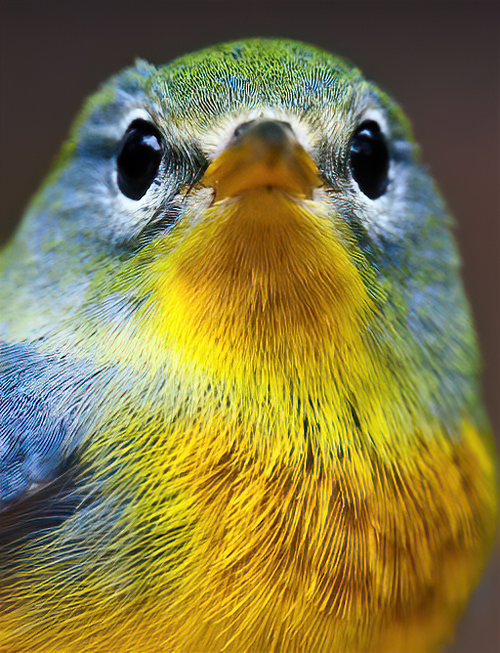

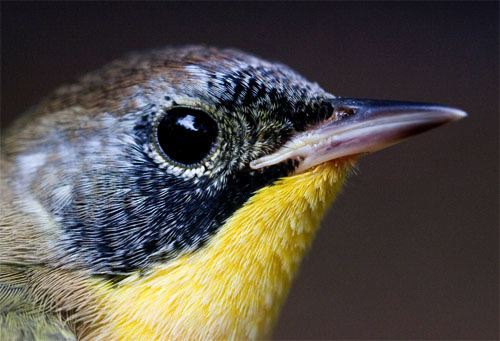
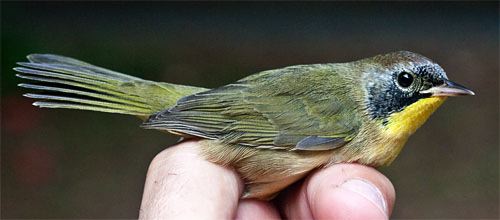

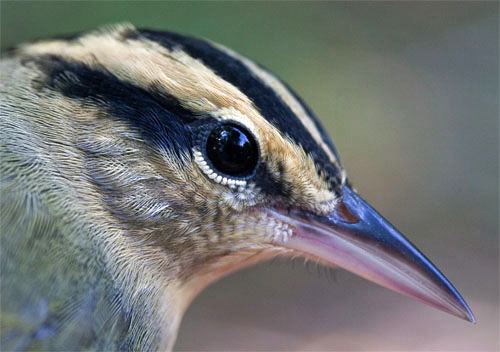
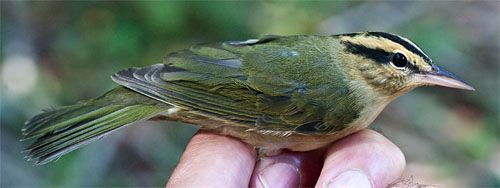
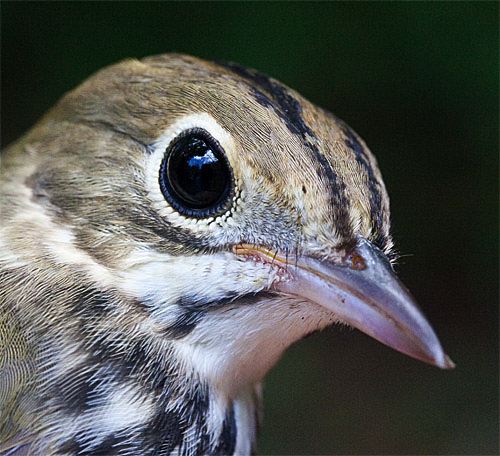
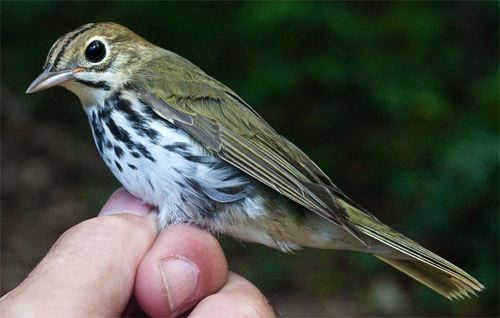

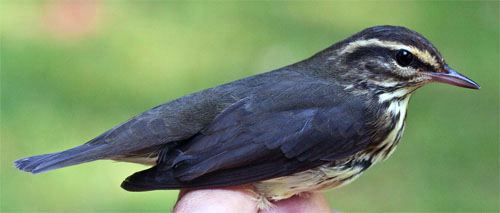

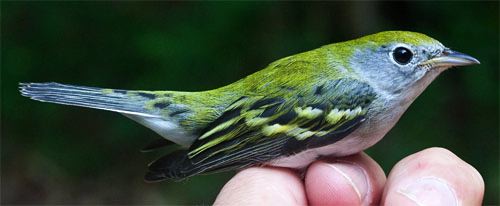
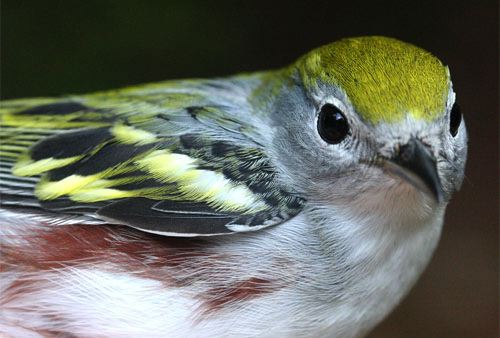
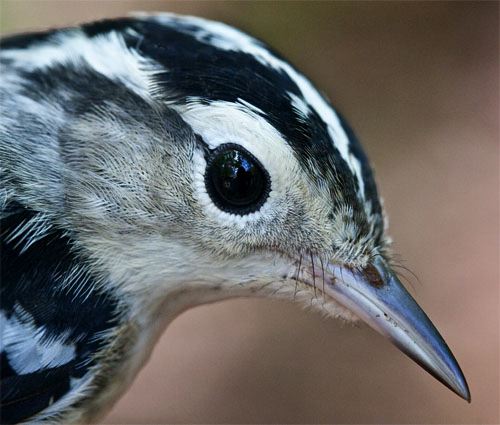
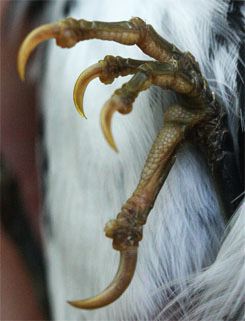 More likely a beginning birder would confuse the Black-and-white Warbler with a small woodpecker, since the warbler's especially long hind toe (right) allows it to cling woodpecker- or nuthatch-style to tree trunks while gleaning insects and spiders from bark crevices. (Note the bill is also quite stout for a warbler.) Quite a few members of this species migrate through the Carolina Piedmont each autumn, with a few occasionally wintering in the Coastal Plain and even further inland. (We've banded 156 Black-and-white Warblers at Hilton Pond Center since 1982, including females with incubation patches.)
More likely a beginning birder would confuse the Black-and-white Warbler with a small woodpecker, since the warbler's especially long hind toe (right) allows it to cling woodpecker- or nuthatch-style to tree trunks while gleaning insects and spiders from bark crevices. (Note the bill is also quite stout for a warbler.) Quite a few members of this species migrate through the Carolina Piedmont each autumn, with a few occasionally wintering in the Coastal Plain and even further inland. (We've banded 156 Black-and-white Warblers at Hilton Pond Center since 1982, including females with incubation patches.) 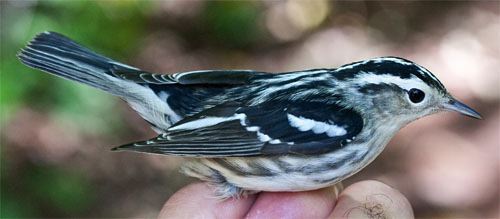



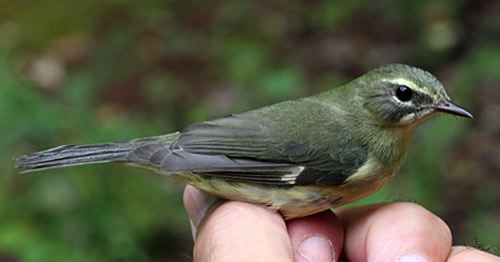
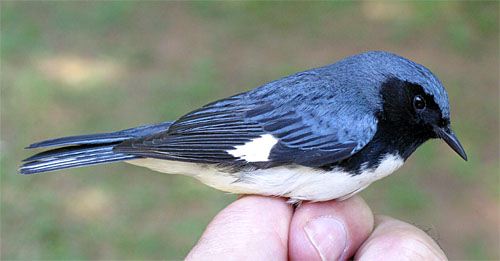
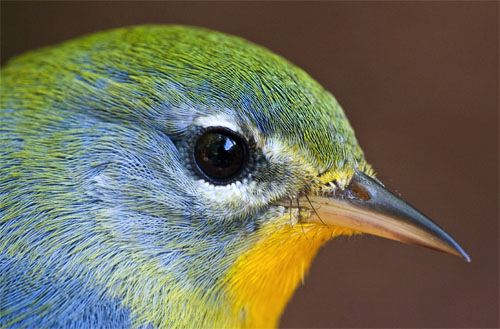
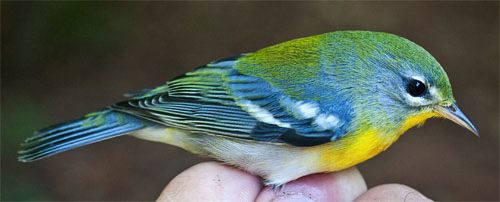
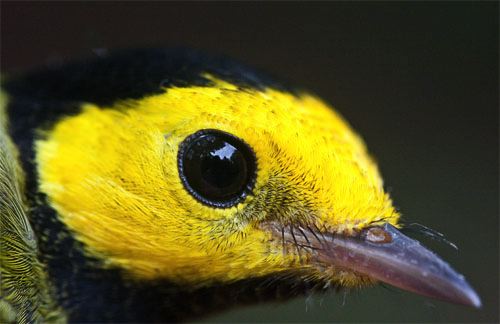
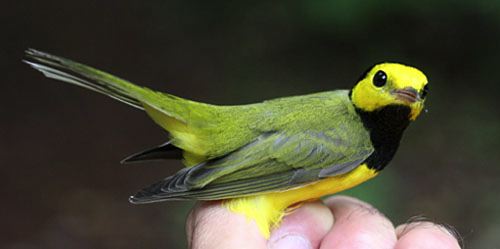

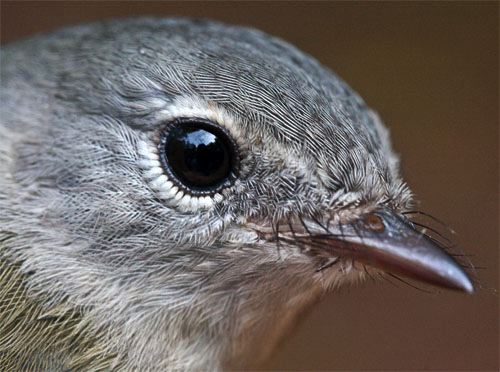
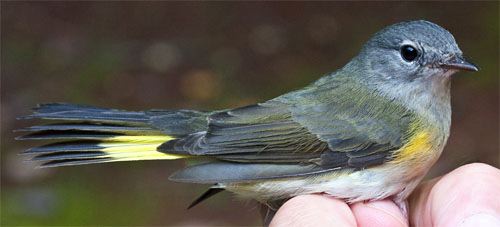
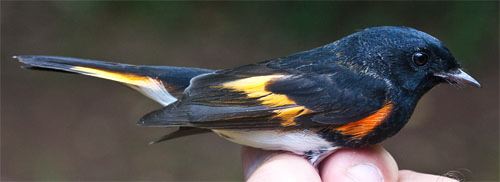






 Please report your
Please report your